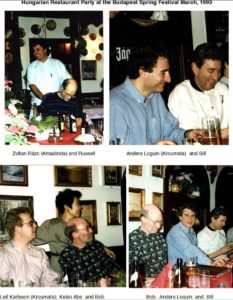 1993 KROUMATA AND AMADINDA IN BUDAPEST In Spring’93 the New York Times pointed out that “Canada takes the spotlight at this year’s Budapest Spring Festival”. We were honoured to represent Canada along with the Canadian Brass, Trio Lyrika, flautist Robert Aitken, pianist Katja Cerovsek and violinists Corey Cerovsek and Erika Raum. (In ‘92, Erika had won first place at the Joseph Szigeti International Violin Competition in Budapest); also the Canadian All Stars jazz ensemble : Ed Bickert, Terry Clarke, Oliver Jones, Dave Young, Jim Galloway and Fraser MacPherson. In addition to several solo concerts, we gave 3 performances of “Ionisation” with Kroumata and Amadinda – What a concert it was! We have since enjoyed more collaborations with both ensembles. Other guests at the festival included Hungary’s foremost wind quintet Aquincum, and the formidable Keiko Abe, although we did not have an opportunity to perform with her. En route to Budapest, we stopped in Hannover, Germany for a performance and workshop, playing the Pavillon to the surprise of the reviewer (attached). The last line of the review is really beautiful: “The stamp that the audience got on their hands as proof of admittance read ‘perfection is a thing for gods’…..one would like to add ‘and for Nexus.’ More: You can listen to the Canadian All Stars’ European Concert here: https://www.amazon.com/European-Concert-Canadian-All-Stars/dp/B001A7H80C
1993 KROUMATA AND AMADINDA IN BUDAPEST In Spring’93 the New York Times pointed out that “Canada takes the spotlight at this year’s Budapest Spring Festival”. We were honoured to represent Canada along with the Canadian Brass, Trio Lyrika, flautist Robert Aitken, pianist Katja Cerovsek and violinists Corey Cerovsek and Erika Raum. (In ‘92, Erika had won first place at the Joseph Szigeti International Violin Competition in Budapest); also the Canadian All Stars jazz ensemble : Ed Bickert, Terry Clarke, Oliver Jones, Dave Young, Jim Galloway and Fraser MacPherson. In addition to several solo concerts, we gave 3 performances of “Ionisation” with Kroumata and Amadinda – What a concert it was! We have since enjoyed more collaborations with both ensembles. Other guests at the festival included Hungary’s foremost wind quintet Aquincum, and the formidable Keiko Abe, although we did not have an opportunity to perform with her. En route to Budapest, we stopped in Hannover, Germany for a performance and workshop, playing the Pavillon to the surprise of the reviewer (attached). The last line of the review is really beautiful: “The stamp that the audience got on their hands as proof of admittance read ‘perfection is a thing for gods’…..one would like to add ‘and for Nexus.’ More: You can listen to the Canadian All Stars’ European Concert here: https://www.amazon.com/European-Concert-Canadian-All-Stars/dp/B001A7H80C
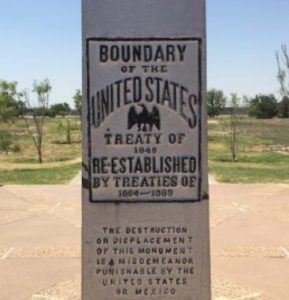 1993 EL PASO TO WAUKESHA And points in between! At Tanglewood, back in ’87, we gave a concert that would have a far-reaching effect on us. In the audience were all the percussion fellows, including Bob’s friend Feza Zweifel, currently timpanist with the National Arts Centre Orchestra (Canada), the “searching and adventurous” pianist Peter Serkin (who sadly passed away just this year), and the indefatigable Betsy Green who was to become our U.S. Representative. It is to Betsy we owe the amazing touring schedules we’ve been telling you about, and we were delighted to celebrate her 90th birthday this summer! In 1993, Betsy had us criss-crossing the Midwest: Muncie, Indiana; Waukesha, Wisconsin; 3-Rivers Festival in Pittsburg; the stunning Gerald R. Ford Amphitheatre in its spectacular Vail valley setting, Colorado; Fayetteville, Arkansas; Grinnell and Cedar Falls in Iowa. We took a breather in October, and then back to Jasper and Indianapolis in Indiana, PASIC’93 in Columbus, Ohio; then down to Clarksville and Memphis in Tennessee, and a final stop in Oklahoma City! Oops. We left out Lubbock and El Paso, Texas! In El Paso we performed at the Chamizal National Memorial, a cultural centre that details the history of the U.S.–Mexico border. That park honours the peaceful resolution of the Chamizal dispute, a more than 100-year border dispute between the United States and Mexico. The border there is marked by the Rio Grande, but the river naturally changed course over time between El Paso and Ciudad Juarez in Chihuahua, Mexico, which led to the dispute. Parks were established in 1963 on both sides of the border on what had been the disputed land! A special place, indeed.
1993 EL PASO TO WAUKESHA And points in between! At Tanglewood, back in ’87, we gave a concert that would have a far-reaching effect on us. In the audience were all the percussion fellows, including Bob’s friend Feza Zweifel, currently timpanist with the National Arts Centre Orchestra (Canada), the “searching and adventurous” pianist Peter Serkin (who sadly passed away just this year), and the indefatigable Betsy Green who was to become our U.S. Representative. It is to Betsy we owe the amazing touring schedules we’ve been telling you about, and we were delighted to celebrate her 90th birthday this summer! In 1993, Betsy had us criss-crossing the Midwest: Muncie, Indiana; Waukesha, Wisconsin; 3-Rivers Festival in Pittsburg; the stunning Gerald R. Ford Amphitheatre in its spectacular Vail valley setting, Colorado; Fayetteville, Arkansas; Grinnell and Cedar Falls in Iowa. We took a breather in October, and then back to Jasper and Indianapolis in Indiana, PASIC’93 in Columbus, Ohio; then down to Clarksville and Memphis in Tennessee, and a final stop in Oklahoma City! Oops. We left out Lubbock and El Paso, Texas! In El Paso we performed at the Chamizal National Memorial, a cultural centre that details the history of the U.S.–Mexico border. That park honours the peaceful resolution of the Chamizal dispute, a more than 100-year border dispute between the United States and Mexico. The border there is marked by the Rio Grande, but the river naturally changed course over time between El Paso and Ciudad Juarez in Chihuahua, Mexico, which led to the dispute. Parks were established in 1963 on both sides of the border on what had been the disputed land! A special place, indeed.
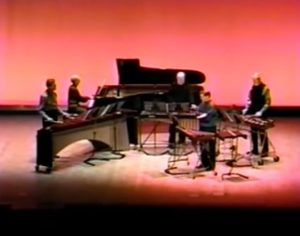 1993 TURNING POINT Bob Becker composed Turning Point in 1993 with NEXUS in mind. This piece for quintet directly followed a trio piece, Prisoners Of The Image Factory, which had been based on music composed to accompany a short film. The structure of Prisoners was completely based on the rhythmic and rapid cutting technique used in the film. Bob had also explored the low range of marimba and piano for Prisoners… and he was interested in the pronounced harmonics that resulted when they were played together. Both the film technique and the low harmonics elements carried over into Turning Point, a much longer more symmetrical piece. Bob says, “Where Prisoners is concrete…Turning Point is abstract, reflecting an imagined sequence of dance tableaus. Prisoners is a miniature tone poem. Turning Point is a miniature ballet suite. Although Turning Point is still based on the interval relationships and resulting harmonies derived from the rag Chandrakauns, it has little relationship to Indian music per se, except for the use, twice, of a rhythmic cadence effect called a ti hai (a three-fold repeat of a specific rhythmic pattern). The use of quintuple meter throughout the piece was not an Indian music influence, but rather a device to add ambiguity to music with a relentless, steady pulse.” Turning Point is written for four percussion and piano. During our criss-crossing of mid-western USA, we premiered Turning Point at the University of Northern Iowa Artists Series in Cedar Falls. It is recorded on There is a Time on the NEXUS label. The photo is NEXUS performing the piece in 1995 in Hondo City, Amakusa, Japan. Sheet music available from MostlyMarimba.com: http://www.mostlymarimba.com/inspiration-and-enlightenment/inspiration/1053-bob-becker-turning-point.html
1993 TURNING POINT Bob Becker composed Turning Point in 1993 with NEXUS in mind. This piece for quintet directly followed a trio piece, Prisoners Of The Image Factory, which had been based on music composed to accompany a short film. The structure of Prisoners was completely based on the rhythmic and rapid cutting technique used in the film. Bob had also explored the low range of marimba and piano for Prisoners… and he was interested in the pronounced harmonics that resulted when they were played together. Both the film technique and the low harmonics elements carried over into Turning Point, a much longer more symmetrical piece. Bob says, “Where Prisoners is concrete…Turning Point is abstract, reflecting an imagined sequence of dance tableaus. Prisoners is a miniature tone poem. Turning Point is a miniature ballet suite. Although Turning Point is still based on the interval relationships and resulting harmonies derived from the rag Chandrakauns, it has little relationship to Indian music per se, except for the use, twice, of a rhythmic cadence effect called a ti hai (a three-fold repeat of a specific rhythmic pattern). The use of quintuple meter throughout the piece was not an Indian music influence, but rather a device to add ambiguity to music with a relentless, steady pulse.” Turning Point is written for four percussion and piano. During our criss-crossing of mid-western USA, we premiered Turning Point at the University of Northern Iowa Artists Series in Cedar Falls. It is recorded on There is a Time on the NEXUS label. The photo is NEXUS performing the piece in 1995 in Hondo City, Amakusa, Japan. Sheet music available from MostlyMarimba.com: http://www.mostlymarimba.com/inspiration-and-enlightenment/inspiration/1053-bob-becker-turning-point.html
1993 ORCHESTRAS AND CHOIR We had four opportunities to perform Takemitsu’s “From me flows what you call Time…” in 1993: three performances In January with the Milwaukeee Symphony Orchestra under Zdenek Macal, one of his final services after 7 years with that symphony before moving to the New Jersey Symphony that September. We also performed “From me flows…” at PASIC’93 with the Columbus Symphony under the baton of George Schram. In Canada we participated in a moving concert with the Toronto Bach-Elgar Choir under director Wayne Strongman, performing Bernstein’s Missa Brevis (composed only 5 years previous) and African Sanctus, and enjoyed a mixed program with Toronto’s Hannaford Street Silver Band conducted by beloved Canadian conductor Victor Feldbrill (whom we just lost this year at age 96). Victor was a great champion of Canadian music and musicians. While in Indiana we performed our family concert The Story of Percussion In The Orchestra with the Indianapolis Symphony conducted by Alfred Savia. The Story of Percussion was our newest CD, released the year prior, 1992. Here is a review of the CD.
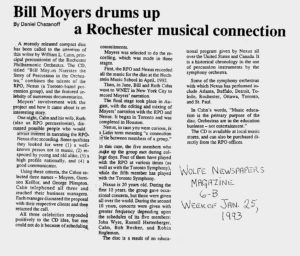
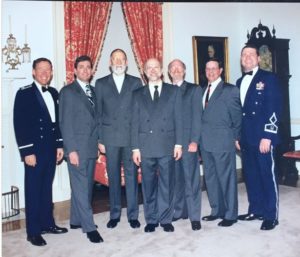
1994 THE FIVE BEATNIKS Having braved a February kids’ concert with the Winnipeg Symphony (Winnipeg is considered the coldest city in Canada), we immediately hightailed it to Florida where we played Daytona Beach and Jacksonville. The Daytona review said, “The concert opened with the five beatniks standing in a row….” In Jacksonville, we were joined by a very young Barbara Hannigan! Bill Cahn conducted the city’s symphony orchestra in 2 performances of “Rags to Riches”, while Maestro Ethan Dulsky conducted a 3rd concert presenting our “Story of Percussion”. From Florida we headed into Georgia, then up to Delaware, then into Washington DC where we had a wonderful opportunity – we performed in the historic Constitution Hall with the U.S. Air Force Band! Again we presented our “Rags to Riches” program conducted by Lt. Colonel Alan R. Bonner (on the left in the photo). Percussionist Randy Eyles is on the right. Thanks to our colleague Michael Schutz, McMaster University professor and former student of Randy Eyles, for sharing Randy’s wonderful photo with us. But we couldn’t stay in the salubrious south any longer. Back to Toronto, where we performed at the newly-opened polyonymous North York Performing Arts Centre – which soon became the Ford Centre for the Performing Arts, then the Toronto Centre for the Arts, and last year the Meridian Arts Centre. In 1993, we had participated in the new centre’s first acoustic tests, playing Music for Pieces of Wood, rags and Ancient Military Aires. Now concertizing there, the review began, “If there was ever an argument for the sensational acoustics of the North York Centre’s Recital Hall, it was last night’s performance by Toronto’s internationally acclaimed percussion ensemble Nexus.”
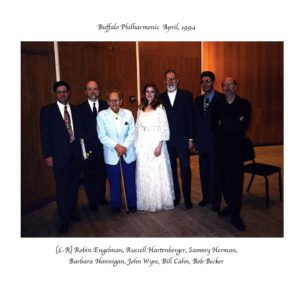 1994 BARBARA HANNIGAN, SAMMY HERMAN, AND VOICES Barbara Hannigan joined us again for several Buffalo Philharmonic concerts conducted by Bill Cahn. She was 23 and had just received her baccalaureate from the University of Toronto. Standing next to her in the photo is Sammy Herman who was inducted into the PAS Percussion Hall Of Fame in ‘94. Gordon Stout called him “one of the greatest xylophonists in our history.” Sammy had amazing technique and said, “As a lefty, I was able to play the melody in the left hand and the harmony notes in the right hand.” You can read his full citation here: https://www.pas.org/about/hall-of-fame/sammy-herman.
1994 BARBARA HANNIGAN, SAMMY HERMAN, AND VOICES Barbara Hannigan joined us again for several Buffalo Philharmonic concerts conducted by Bill Cahn. She was 23 and had just received her baccalaureate from the University of Toronto. Standing next to her in the photo is Sammy Herman who was inducted into the PAS Percussion Hall Of Fame in ‘94. Gordon Stout called him “one of the greatest xylophonists in our history.” Sammy had amazing technique and said, “As a lefty, I was able to play the melody in the left hand and the harmony notes in the right hand.” You can read his full citation here: https://www.pas.org/about/hall-of-fame/sammy-herman.
Barbara Hannigan also premiered Bob Becker’s Cryin’ Time at the UofT. Bob says, “Sometimes a piece has forced itself on me as a response to an intense emotional experience, as with Cryin’ Time… At other times, there has been a kind of imperative in the work itself…Never in Word is an example of that.” You can hear Cryin’ Time and other pieces from Bob’s CD There is a Time ( released ‘94) here: https://www.nexuspercussion.com/2017/09/more-from-bobs-archive-part-4/
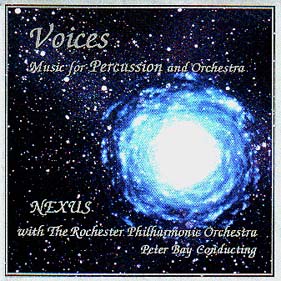 We also released our CD Voices, featuring the Rochester Philharmonic conducted by Peter Bay, presenting Bill’s piece Voices along with his The Birds and Kebjar-Bali, and John Wyre’s Connexus. You can hear these 2 here: https://www.nexuspercussion.com/1994/12/voices/. The album cover features a painting entitled Proto-Galaxy by Victor A Costanzo, courtesy of the Strasenburgh Planetarium of the Rochester Science Center. Costanzo’s amazing renderings of our universe grace the pages of the book Night Watch by prolific Canadian science writer #TerenceDickinson. (Dickinson has received many honours and awards, not least having the asteroid 5272 Dickinson named for him!) Night Watch is in its 4th edition, the top-selling stargazing guide in the world for the last 20 years. The beautiful Costanzo illustrations are a major attraction. You can see Night Watch here: https://bit.ly/2HF92T8.
We also released our CD Voices, featuring the Rochester Philharmonic conducted by Peter Bay, presenting Bill’s piece Voices along with his The Birds and Kebjar-Bali, and John Wyre’s Connexus. You can hear these 2 here: https://www.nexuspercussion.com/1994/12/voices/. The album cover features a painting entitled Proto-Galaxy by Victor A Costanzo, courtesy of the Strasenburgh Planetarium of the Rochester Science Center. Costanzo’s amazing renderings of our universe grace the pages of the book Night Watch by prolific Canadian science writer #TerenceDickinson. (Dickinson has received many honours and awards, not least having the asteroid 5272 Dickinson named for him!) Night Watch is in its 4th edition, the top-selling stargazing guide in the world for the last 20 years. The beautiful Costanzo illustrations are a major attraction. You can see Night Watch here: https://bit.ly/2HF92T8.
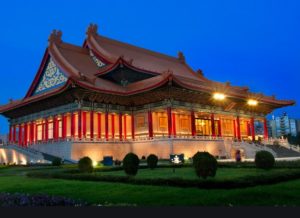
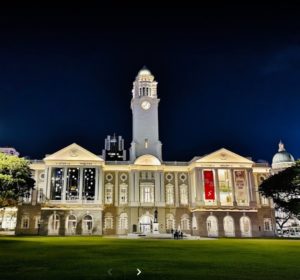
1994 “NO DISTINCT MELODY”: SINGAPORE, HONG KONG, TAIWAN In June, Singapore/Hong Kong. In October, Taiwan. Those instrument cases were getting a lot of use! We spent several days at the Singapore Festival performing in the imposing Victoria Concert Hall with its clock tower. That year, “this tiny island nation of three million was able to support a S$5.5 million festival featuring 114 core performances spread out over 35 days.” The review: Reich’s Music for Pieces of Wood: “no distinct melody…plenty of repetition. Yet…compelling.” Takemitsu’s Raintree: “no clear melody – not even a dissonant one.” The review ends, “Even though much of it was from the cutting edge of contemporary music, it was hard not to like it…” (That’s what we had been hoping for.) A ‘96 article provides context. Written by Prof. Wm. Peterson who had taught in Singapore, the Asian Theatre Journal article looks at that 1994 Festival and discusses how Singapore’s economic pragmatism was being applied to the arts at that time. Peterson addresses such problems as the conflict between an authoritarian, censorship-obsessed government and the free expression of ideas, and introducing artistically challenging experimental theatre for unprepared audiences. (We actually gave a workshop on the Music of Steve Reich while at the festival!) From Singapore we did a concert stop at the Hong Kong City Hall and then headed home. October found us back in East Asia performing in the beautiful National Concert Hall in Taipei with its sweeping roof lines, which had opened just a few years prior (1987). In addition to our solo concert we also performed our Story of Percussion with the National Taiwan Orchestra under the baton of Hsu Ching-hsin. You can find Prof. Peterson’s article here: https://www.jstor.org/stable/1124305?seq=1
1994 “CONTEMPORARY WITHOUT BEING CONTEMPTIBLE” Zdenek Macal who had conducted our “From me flows what you call Time…” as one of his last services in Milwaukee in 1993, now had us for 3 performances of the concerto in his new position as music director of the New Jersey Symphony Orchestra. #GeorgeManahan conducted us in Connexus and the Carmen Suite in Virginia – Maestro Manahan had also served as conductor of the Steve Reich Ensemble, and during his Richmond Symphony tenure, that orchestra received 5 ASCAP awards for “Adventuresome Programming of Contemporary Music”. Donald Bick conducted our From Rags to Riches concert, along with Bill Cahn, with the Virginia Commonwealth University Orchestra. Professor Bick passed away in 2004 and was deeply mourned: “The school has certainly lost one of the finest musicians around. He was not only a great percussionist but he was also a fantastic conductor,” said former student and associate professor Mike Boyd. “He built this program [at VCU] into something quite phenomenal.” Our Takemitsu concerto also had an outing with the #SacramentoSymphony under our old friend #BorisBrott. Maestro Brott had taken a chance on us in our very first year of existence (1971) with the Hamilton (Ontario) Philharmonic and again in ’74 with the Chautauqua Symphony, and then again in 1989 with Canada’s National Arts Centre Orchestra. In his introductory remarks to the audience, Brott described the Takemitsu work as “contemporary without being contemptible”.
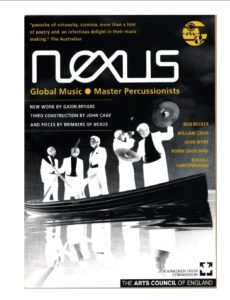 1994 ONE LAST BAR, THEN JOE CAN SING In mid-November we premiered Gavin Bryars’ new commission, “One Last Bar, Then Joe Can Sing” at Queen Elizabeth Hall in London, England then toured it (along with other repertoire) to 6 other cities. Gavin describes One Last Bar… : “Commissioned by the Arts Council of Great Britain for the virtuoso percussion quintet Nexus, this piece is a reflection on aspects of percussion history, both personal and musical. The members of Nexus are my friends (I played in the Steve Reich Ensemble along with Russ Hartenberger, for example, in 1972 – the year after Nexus was formed) and I have known their playing as an ensemble for almost 20 years. The piece exploits not only the tremendous virtuosity of Nexus but rather more their wonderful musicality and subtlety.” Read more about our rare 3-octave songbells and why One Last Bar… is “a kind of homage to Deagan” on Gavin’s website: https://bit.ly/3eajw8C
1994 ONE LAST BAR, THEN JOE CAN SING In mid-November we premiered Gavin Bryars’ new commission, “One Last Bar, Then Joe Can Sing” at Queen Elizabeth Hall in London, England then toured it (along with other repertoire) to 6 other cities. Gavin describes One Last Bar… : “Commissioned by the Arts Council of Great Britain for the virtuoso percussion quintet Nexus, this piece is a reflection on aspects of percussion history, both personal and musical. The members of Nexus are my friends (I played in the Steve Reich Ensemble along with Russ Hartenberger, for example, in 1972 – the year after Nexus was formed) and I have known their playing as an ensemble for almost 20 years. The piece exploits not only the tremendous virtuosity of Nexus but rather more their wonderful musicality and subtlety.” Read more about our rare 3-octave songbells and why One Last Bar… is “a kind of homage to Deagan” on Gavin’s website: https://bit.ly/3eajw8C
There’s a great Bryars’ interview on Culturekiosque’s Klassiknet where he discusses One Last Bar…, NEXUS, and the importance of percussion: klassiknet: In “One Last Bar… you wrote for NEXUS, the acoustical research seemed obvious. Bryars: Percussion always interested me. Percussion music is 20th Century music, and there isn’t much percussion music outside of ethnic music. klassiknet: World music must interest you. There were gamelan sounds in your scores. Bryars: Absolutely. Living in England we hear a lot of Indian music. The nearest town to where I live is 25% Asian. A percussion ensemble can be as flexible and as expressive as a string quartet, and especially a group like Nexus which has lived and worked together for 25 years. Whilst on the surface, instruments like the xylophone, marimbas etc. appear inflexible, and not at all expressive, for me they are perfectly capable of being expressive in the right hands. When I was teaching at the university back in the 70s I required my students to study percussion. They had to play rhythm accurately, and come to turns with the music of the 20th Century. Otherwise, violinists, say, can get away with just playing 17th, 18th and 19th century music. It meant people had to take more responsibility as performers. It also meant that people had access to a lot of repertoire to tune percussion music such as transcriptions by Percy Grainger, things of Henry Cowell, as well as repetitive music by Steve Reich and Terry Riley and so on. I have two percussionists in my ensemble. How the whole range of percussion is used colouristically and as a full section in an orchestra is very important. In my first opera “Medea” I got rid of the violins, but I had a team of five tune percussion players, plus the tympanist. Effectively, they became like the leaders of the orchestra. They carried the musical momentum in the piece. Percussionists are key players now.” Read the rest of the interview here: https://bit.ly/2GcSnp2
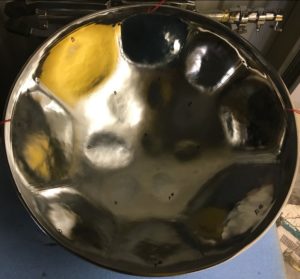
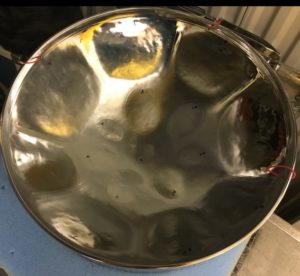
1994 BOB’S NEW STEEL PANS Around this time we were starting to receive the music for new commissions from Bruce Mather and Michael Colgrass – we will tell you more about that in future posts. But the music demanded steel pans. And NEXUS was touring a great deal. Bob says, “Takemitsu’s concerto was in demand and my pans, safely in Case 21, were often in transit by truck or air freight during times when I needed them for practice. Early in 1994 my steel pan savior, Paul Ormandy, had taken them along with some of his own drums to a relatively new company in the U.S. called Panyard to get a tuning touch-up known as a “blend”. I mentioned my problem to Paul and asked him to find out if Panyard could copy the old Phase II tuning on a new set of double tenors. I needed exact copies – same dimensions for each pan, and precise placement and size of every note. The tuners at Panyard took measurements of my instruments, and then I got a phone call from one of the owners of the company, Shelly Irvine, asking me if I would be interested in a free pair of new pans in exchange for giving Panyard an endorsement and permission to use my photo in their advertising. At the time I considered myself an absolute novice pan player (I still do) and was surprised by his offer, but I said if the pans they make are what I need, and sound even close to my Harrigin pans, I would be agreeable. I soon received a new set of double tenors that perfectly matched my originals. Although the Panyard instruments were slightly darker sounding, and had a bit more resistance than Harrigin’s, they were beautifully tuned and crafted. In addition, Panyard sent me a pair of stands with carrying bag, and heavy-duty cases for the pans. I was very happy to agree to their terms, and for several years my photo appeared in Panyard’s advertising along with many really great players. I often cringed when I saw my picture in their catalogues.”
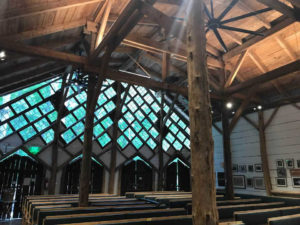 1994 CONTINUOUS CAGE Our future NEXUS member, Garry Kvistad, who had just been honored in ’93 by Northern Illinois University with its Distinguished Alumni Award (he received his MM there), writes about his “Woodstock Beat” concert series. “NEXUS members have been performing in Woodstock NY since 1990 to benefit the original arts group founded in 1903 called the Byrdcliffe Arts Colony. In 1994 we moved this annual concert from the barn at Byrdcliffe to Maverick Hall, a beautiful hand-hewn ‘music chapel’ in the woods near Woodstock. Maverick Hall was built in 1916 by Hervey White who was one of the original artists of the colony. This hall has been an acoustically excellent venue for concerts every summer since then, and is the home of America’s oldest continuous summer chamber music festival. One very important concert at Maverick was the 1952 premiere of Cage’s seminal work entitled 4’ 33”.” Russell Hartenberger takes up the 1994 story: “For those of us who have known Cage and grown up under his influence, Maverick is a musical shrine. As an homage to Cage, Garry, in our first Woodstock Beat concert at Maverick in ‘94, printed in the program and announced to the audience that Cages “4’33”” was being performed continuously throughout the concert.”
1994 CONTINUOUS CAGE Our future NEXUS member, Garry Kvistad, who had just been honored in ’93 by Northern Illinois University with its Distinguished Alumni Award (he received his MM there), writes about his “Woodstock Beat” concert series. “NEXUS members have been performing in Woodstock NY since 1990 to benefit the original arts group founded in 1903 called the Byrdcliffe Arts Colony. In 1994 we moved this annual concert from the barn at Byrdcliffe to Maverick Hall, a beautiful hand-hewn ‘music chapel’ in the woods near Woodstock. Maverick Hall was built in 1916 by Hervey White who was one of the original artists of the colony. This hall has been an acoustically excellent venue for concerts every summer since then, and is the home of America’s oldest continuous summer chamber music festival. One very important concert at Maverick was the 1952 premiere of Cage’s seminal work entitled 4’ 33”.” Russell Hartenberger takes up the 1994 story: “For those of us who have known Cage and grown up under his influence, Maverick is a musical shrine. As an homage to Cage, Garry, in our first Woodstock Beat concert at Maverick in ‘94, printed in the program and announced to the audience that Cages “4’33”” was being performed continuously throughout the concert.”
Garry mentions that, “In 2010, that famous and infamous work was recorded in England by some leading pop stars and was nominated for the Best Holiday Song of 2010. I think John would have been amused to see this happen. Maverick was a great place to premier this piece since the ambient sounds become the piece. Being in the middle of the Catskill Park with un-insulated walls and an open end, the natural sounds of the environment are abundant during concerts. This would be in contrast to a recording studio which by its very nature is quiet and controlled. Cage was so far ahead of his time, we had to wait nearly 60 years for the pop world to catch up to him!” You can read more about Maverick Hall and its colourful history here: https://maverickconcerts.org/history/ Michael Burritt took the above photo of Maverick Hall a few years ago when he performed there with NEXUS.
